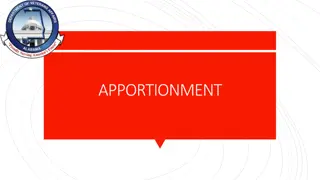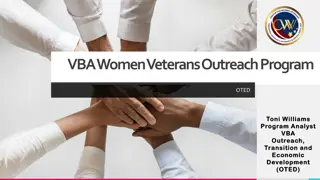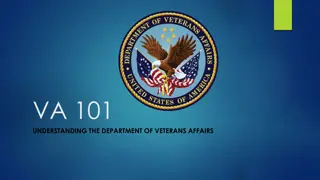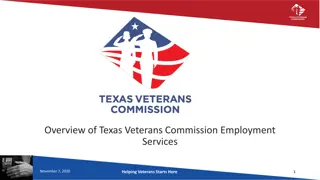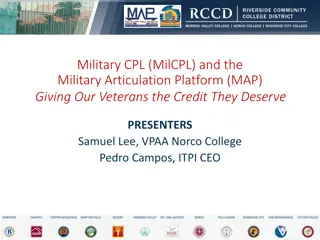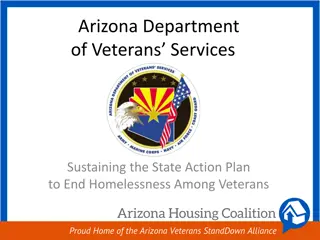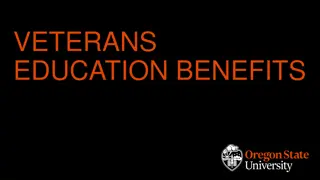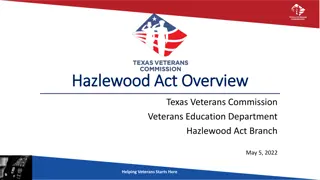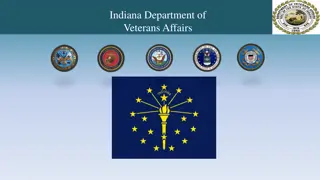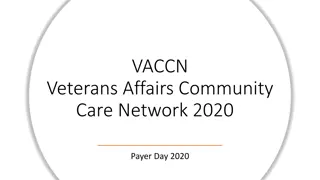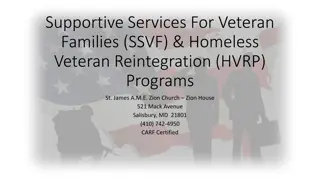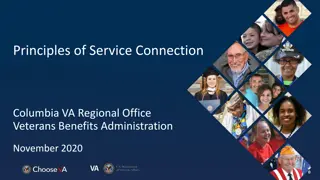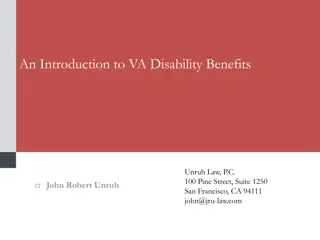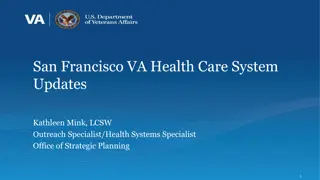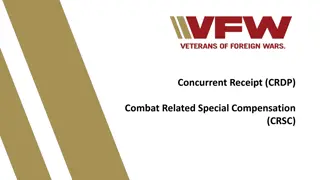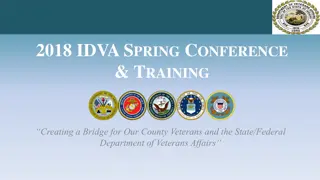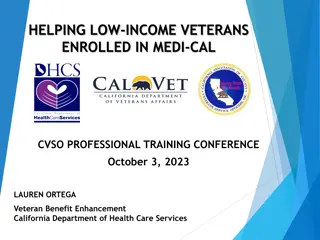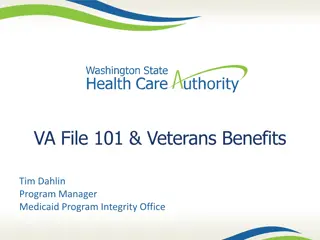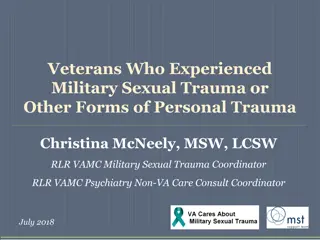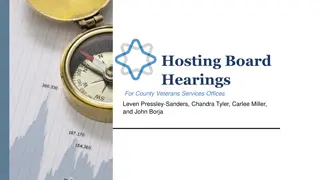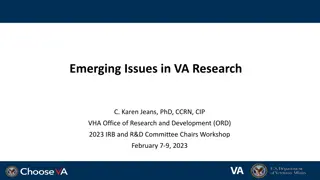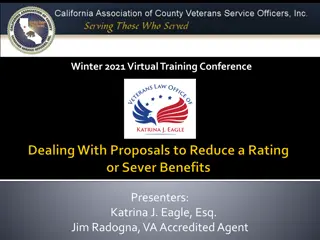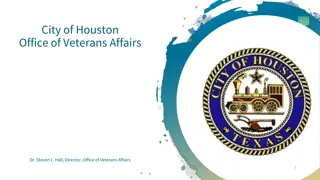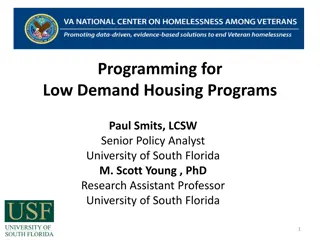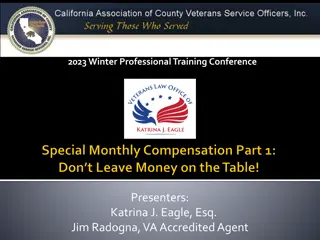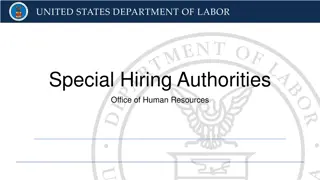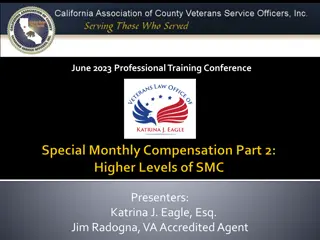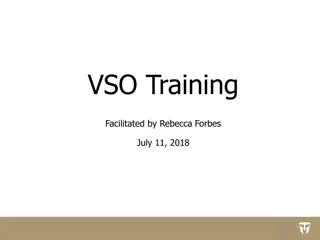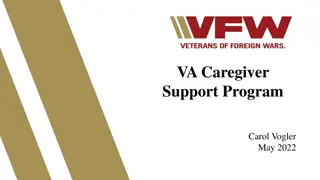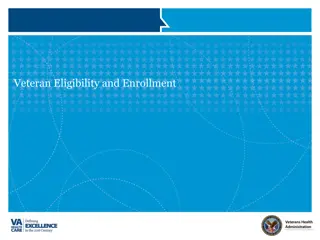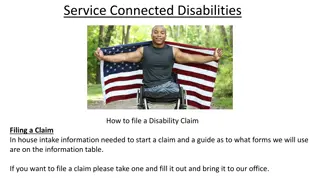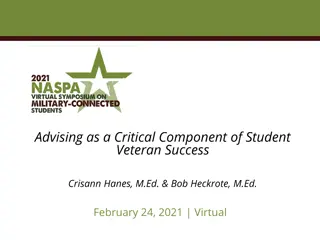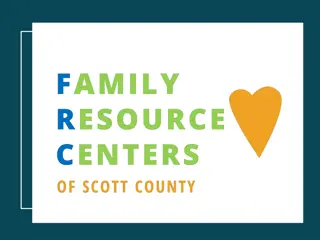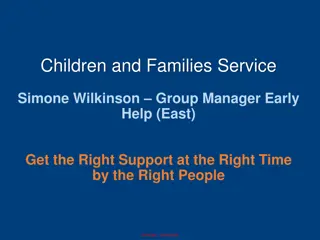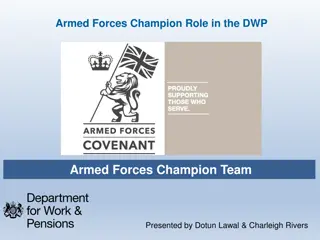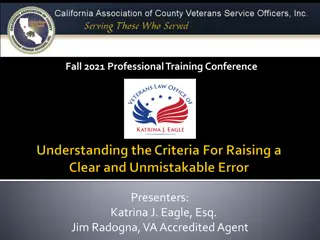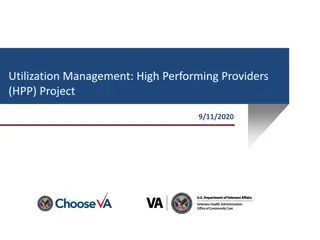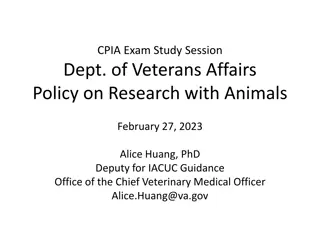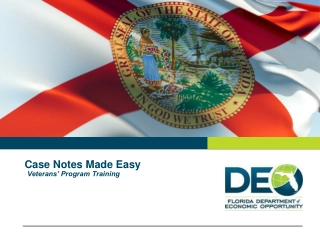V.A. Education Benefits for Veterans and Families
The Department of Veterans Affairs offers Education Assistance allowances for eligible veterans, active duty servicemembers, Reservists, and their families, following specific criteria such as honorable discharge and service duration. Programs like the Montgomery GI Bill provide educational benefits to those who meet the requirements. Various resources and manuals are available to guide veterans and their dependents in choosing suitable education paths.
Download Presentation

Please find below an Image/Link to download the presentation.
The content on the website is provided AS IS for your information and personal use only. It may not be sold, licensed, or shared on other websites without obtaining consent from the author. Download presentation by click this link. If you encounter any issues during the download, it is possible that the publisher has removed the file from their server.
E N D
Presentation Transcript
V.A. EDUCATION BENEFITS Helping veterans and their families choose the right education paths.
REFERENCES Title 38, U.S. Code, Chapters 30, 32, and 33 Title 10, U.S. Code, Chapters 1606 and 1607 38 Code of Federal Regulations, Part 21, Subparts G, K, and L, 21.5001 21.5296 and 21.7000 21.7807 Public Law 99-399 Executive Order 12598 Education Procedures Manual M22-4, Parts 3 6; Part 8. Veterans Benefits Manual, 11.2
REFERENCES FOR VOC REHAB Title 38, U.S. Code, Chapter 31 and Chapter 41 38 Code of Federal Regulations, Part 21, Subpart A, 21.1 21.430 Adjudication Manual M21-1MR (Manual Rewrite), Part IX, Subpart i, Chapter 1 Vocational Rehabilitation and Counseling Procedures Manual M28-1 Veterans Benefits Manual, 11.3 Federal Benefits for Veterans, Dependents and Survivors
REFERENCES FOR SURVIVORS AND DEPENDENTS EDUCATION ASSISTANCE Title 38, U.S. Code, Chapter 35 38 Code of Federal Regulations, Part 21, Subparts C and D, 21.3020 21.4280 Public Law 111-32 Education Procedures Manual M22-4, Part 7 Veterans Benefits Manual, 7.6 Federal Benefits for Veterans, Dependents and Survivors
OVERVIEW The Department of Veterans Affairs provides an Education Assistance allowance for certain eligible veterans, active duty servicemembers, members of the Selected Reserve, other Reservists and National Guard members who are called to active duty, and to certain civilians and their family members who are covered under the Omnibus Diplomatic Security and Antiterrorism Act of 1986 (Public Law 99-399) and Executive Order 12598. All of these programs are also available for active duty personnel. However, active duty personnel normally apply through the INSTALLATION education office, so County Veterans Service Representatives would not need to assist them with their applications.
MONTGOMERY GI BILL (CHAPTER 30) The veteran must have an honorable discharge; general under honorable conditions) discharges do not qualify. The veteran must have entered service on or after July 1, 1985. The veteran must have fulfilled minimum length of service requirements. The minimum length is 36 months of continuous service, unless the term of service was less than three years, in which case the minimum is 24 months of continuous service. The minimum length of service requirements do not apply if the veteran was discharged: because of hardship, for the convenience of the government, for disability, because of a non-disabling medical condition which interferes with performance of duty, or because of a reduction in force
MONTGOMERY GI BILL (CHAPTER 30) BENEFIT LIMITATIONS The veteran has 10 years from the date of final discharge from the period of qualifying service to use the benefits. This period may be extended if the veteran re-enters active service for at least 90 days or is prevented from training because of a disability (including the disabling effects of chronic alcoholism), or because of being held by a foreign government or power.
POST 9/11 GI BILL (CHAPTER 33) Veterans who receive full benefits under Chapter 33 receive full tuition and fees, a monthly housing stipend, and a stipend for books and supplies, for up to 36 months of post-secondary education. This benefit can also be used for on-the-job training or apprenticeship programs.
POST 9/11 GI BILL ELIGIBILITY REQUIREMENTS The veteran must have served, beginning on or after September 11, 2001, an aggregate of at least 36 months on active duty in any of the Armed Forces. The veteran must have received a fully honorable discharge. Full benefits are also available to veterans who served at least 30 consecutive days and were discharged or released from active duty due to a service-connected disability.
POST 9/11 GI BILL BENEFIT LIMITATIONS The veteran has 15 years from the date of final discharge from the period of qualifying service to use the benefits. This period may be extended if the veteran reenters service for at least 90 days or is prevented from training because of a disability. Requirements for limited benefits Veterans who served between 90 days and 36 months and received an honorable discharge are eligible for tuition, fees, and a monthly stipend on a pro rata basis, based upon their length of service.
POST 9/11 GI BILL BENEFITS FOR DEPENDENTS If your service ended before January 1, 2013, your Post-9/11 GI Bill benefits will expire 15 years after your last separation date from active service. You must use all of your benefits by that time or you ll lose whatever s left. If your service ended on or after January 1, 2013, your benefits won t expire thanks to the Forever GI Bill - Harry W. ColmeryVeterans Educational Assistance Act.
EDUCATIONAL ASSISTANCE UNDER 10 U.S. CODE CHAPTER 1607 The Reserve Educational Assistance Program (REAP) provides educational assistance for reserve component members supporting contingency operations and certain other operations. The program is for members of the Selected Reserves, the Individual Ready Reserves (IRR), and the National Guard who have been called to active duty for 90 consecutive days or longer since September 11, 2001. This is a combined program, jointly administered by VA, the Department of Defense, and the Department of Homeland Security. An eligible Reservist under Chapter 1607 is entitled to 36 months of education assistance benefits, or, if entitled under more than one program, to a maximum of 48 months combined under all programs to which entitled.
CHAPTER 1607 BENEFIT LIMITATIONS There is no ending date by which a Reservist or Guard member must use the benefits, except for members of the Ready Reserve who are released from active duty for disability not due to willful misconduct in these cases, the period of eligibility ends 10 years from the date eligibility was initially established. For all others, eligibility continues so long as the member continues to serve in the same Reserve component or the National Guard, except that a member called up from the Selected Reserve would not remain eligible if the member then went into the Individual Ready Reserve (IRR).
WHAT IF A CLAIMANT IS ELIGIBLE TO BENEFITS UNDER MORE THAN ONE PROGRAM? If a person has eligibility for benefits under more than one education or training program, including also Vocational Rehabilitation or Dependents Education Assistance, the maximum amount of entitlement allowed under all programs combined is 48 months. The veteran or eligible person must choose under which program benefits are to be paid for any given course or enrollment period. All programs charge entitlement to benefits at the rate of one day of entitlement per one day of full-time training; the entitlement charges are prorated for training at less than full-time.
V.A. REGIONAL PROCESSING OFFICE JURISDICTION OVER EDUCATIONAL BENEFITS CLAIMS FOR ALABAMA V.A. Regional Office P.O. Box 8888 Muskogee, OK 74402-8888
VOCATIONAL REHABILITATION AND EMPLOYMENT (CHAPTER 31) The Vocational Rehabilitation Program is designed to help a service-disabled veteran overcome employment handicaps imposed by such a disability (or multiple disabilities) so that the veteran is able to find and keep suitable employment as well as achieve maximum independence in daily living. The primary goal of the program is to train veterans with disabilities for appropriate employment; although, education benefits for school attendance may be authorized if that is determined to be the best way to prepare a particular veteran for entry or re-entry into the labor force. Vocational Rehabilitation benefits are not a supplement to, or a substitute or replacement for, V.A. education assistance benefits available under other programs and must not be viewed as such.
ELIGIBILITY REQUIREMENTS Service-connected disability or disabilities ratable at 20% or more and have an employment handicap resulting primarily from such disability. A veteran with a 10% service-connected disability (including multiple non- compensable conditions for which compensation is paid at the 10% rate under 38 C.F.R. 3.324) may also qualify upon showing that such a disability produces a serious employment handicap. The period of eligibility is 12 years from date of discharge from service or 12 years from the date the V.A. first notifies the veteran of a qualifying service- connected disability, whichever date is later. This may be extended for those severely disabled veterans who are unable to begin or complete their program within that time either (1) because of their disability, or (2) because they are deemed to have a severe employment handicap such that they require additional time for rehabilitation. A veteran who applies for Vocational Rehabilitation must be entitled to receive compensation (or would be entitled but for the receipt of military retired pay). An active duty service member who is hospitalized awaiting separation from service for disability may apply for Vocational Rehabilitation without applying for compensation.
WHAT HAPPENS WHEN AN APPLICATION IS RECEIVED? When an application is received and it is established that a qualifying degree of service-connected disability is present, the applicant will be given counseling, testing, and evaluation to determine whether an employment handicap exists, and if so, whether training and/or rehabilitation services are feasible or necessary.
REHABILITATION PROGRAMS MAY INCLUDE: 1. Employment (including self-employment) services and assistance; 2. Educational (college-level) or vocational (trade, business or technical school)training; 3. Apprenticeship or on-the-job training; or, 4. Farm cooperative training. Note: For severely disabled veterans, there may be training in a rehabilitation facility, in a sheltered workshop, or in-home. The program may also include independent living services and training.
ACCOMPANYING MONETARY BENEFIT While in training, a veteran will be paid a monthly subsistence allowance that varies according to the type and rate of training, the number of dependents, and other factors. Those who are eligible for both Vocational Rehabilitation and the Post 9/11 GI Bill benefits may choose the Post 9/11 GI Bill s monthly housing allowance instead of the Vocational Rehabilitation subsistence allowance. The V.A. will pay all training expenses, including tuition, fees, books, and supplies, and the cost of any necessary tools, equipment, and uniforms. The veteran is also entitled to any and all medical and dental treatment (or reimbursement for the costs of such treatment), including prosthetic devices or other special equipment and special restorative services, necessary to continue or complete his or her program.
MONETARY BENEFIT - CONTINUED When necessary, the veteran may be provided special help such as tutoring assistance, readers for the visually impaired, or sign language interpreters for the hearing impaired. If the veteran encounters unexpected financial difficulties while training, a no-interest loan service is available. Counseling services, such as educational, vocational, personal, and employment counseling are available as well as career planning and job placement services.
VOCATIONAL REHABILITATION AND INDIVIDUAL UNEMPLOYABILITY A veteran who is rated as totally disabled because of individual unemployability may apply for, and pursue, a program of Vocational Rehabilitation without jeopardizing her or his total disability rating. Even if the veteran is then rehabilitated and obtains employment, the total disability rating will continue undisturbed for a minimum of twelve (12) additional months before action is initiated to reduce the rating. This grace period is intended to allow the veteran time to demonstrate that he or she is able to maintain substantially gainful employment and is no longer unemployable.
SURVIVORS AND DEPENDENTS EDUCATIONAL ASSISTANCE (CHAPTER 35) The V.A. provides an educational assistance allowance for certain family members of veterans and servicemembers under Title 38 U.S. Code, Chapter 35. When analyzing eligibility for Chapter 35 benefits, ask these questions: Is there a qualifying veteran or servicemember? ; Is there an eligible family member? ; What is the eligibility period to use the benefits? ; What is this family member s entitlement?
QUALIFYING VETERANS AND SERVICEMEMBERS (Chap 35) Eligibility is based on a family relationship to certain disabled or deceased veterans or servicemembers. This includes veterans who: are rated permanently and totally disabled from service-connected disabilities; died as the result of a service-connected disability; died from any cause not the result of willful misconduct, and who at the time of death were rated as being permanently and totally disabled from service-connected disabilities; died in service.
QUALIFYING VETERANS AND SERVICEMEMBERS (Chap 35) - CONTINUED Chapter 35 benefits are also available to family members of an active servicemember who: is listed as being missing in action or a prisoner of war for more than 90 days, or who is forcibly detained or interned in the line of duty by a foreign government or power for more than 90 days; or has a qualifying permanent and total disability incurred or aggravated in the line of duty for which he or she is hospitalized or is undergoing outpatient treatment, and for which he or she will be discharged from service.
ELIGIBLE FAMILY MEMBERS Chapter 35 benefits are available to certain spouses, surviving spouses, and children of qualifying veterans.
LIMITATIONS ON ELIGIBILITY FOR SPOUSES AND SURVIVING SPOUSES If a spouse divorces from a veteran, the spouse will lose eligibility at the end of that school term. If the veteran remarries, the new spouse becomes an eligible spouse. The surviving spouse is the spouse married to the veteran at the time of death. A surviving spouse who is under 57 years old loses eligibility if they remarry. That remarried surviving spouse will regain eligibility as a surviving spouse if the subsequent marriage ends by death or divorce. A surviving spouse who is at least 57 years old does not lose eligibility if he or she remarries. An eligible spouse loses eligibility while serving in the Armed Forces, and they must be discharged under other than dishonorable conditions in order to resume benefits upon separation from service. A spouse or surviving spouse can receive Chapter 35 benefits at the same time that they are receiving compensation, pension, DIC, or death pension benefits.
LIMITATIONS ON ELIGIBILITY FOR CHILDREN A dependent child of a qualifying veteran or servicemember becomes eligible for Chapter 35 benefits at the age of 18, or when they finish high school, whichever is earlier. A child over the age of 18 may not receive Chapter 35 benefits at the same time that the V.A. provides compensation, pension, or DIC dependency allotments based on their school attendance. There is an exception to this rule for children who are helpless. In that case, the child may receive education assistance at the same time that they receive compensation, pension, or Dependency and Indemnity Compensation.
SUMMARY As you can see, there are many educational benefits available to veterans and their families. Stay current on the eligibility requirements and processes governing: Various G.I. Bill programs Vocational Rehabilitation Chapter 35


